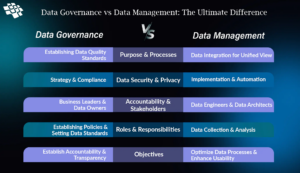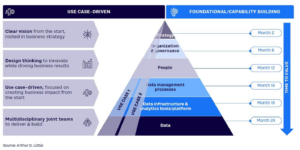
Image created by Midjourney
In the world of big data, there are two terms you’ll hear more than any other: data management and data governance. While they are related, the two terms have different meanings, and it’s important to understand the differences if your organization is going to have an effective overall data strategy.
Tableau perhaps has the most succinct description of the differences between the two terms. “In the simplest terms, data governance establishes policies and procedures around data, while data management enacts those policies and procedures to compile and use that data for decision-making,” the Salesforce-owned BI and analytics company states in a blog post.
Informatica also has a good take on the difference between data management and data governance. “Data governance is a set of principles, standards, and practices. They apply to the end-to-end lifecycle of data (collection, storage, use, protection, archiving, and deletion). This ensures your data is reliable and consistent,” the data integration leader writes in a blog.
“Data management is the technical implementation of data governance,” Informatica continues. “Data governance without implementation is just documentation. Data management enables the execution and enforcement of policies and processes for the organization.”
The consulting firm Arthur D. Little sheds a little more light on the differences between data governance and data management. Data governance is “a strategic, policy-driven framework for a business’s approach to data,” the company writes in a recent report. It “defines the rules, roles, and responsibilities related to data assets.”
Data management, on the other hands, is “the technical and operational aspects of handling data,” which “includes processes such as data collection, storage, integration, and security.”
The activities that fall under data governance will tend to be higher level. It will involve executives and senior members of the team, including CIOs and data stewards, who set the overall strategy, create the standards, and define the roles of the other team members who will actually put the data governance strategy into action. Data governance teams will set the goals for data quality and set the rules for who can access what pieces of data for which use cases.
The activities that fall under the data management are the day-to-day tasks of the workers who are enacting the policies and procedures set by the data governance team above. They will be the data engineers and other data professionals who are responsible for building and running the ETL/ELT data pipelines, administering the data catalog, enforcing data access policies, and managing the data lake/warehouse, among others.
In some organizations, the line of demarcation between the data governance side of the house and the data management side will be clear and well-defined, while in other organizations, the line may be ill-defined and blurred. The same individual may simultaneously be responsible for setting policy (data governance) and implementing policy (data management) in smaller organizations, whereas in some larger institutions, such wearing of multiple hats may actually be against industry regulations.
In the best case scenario, the two disciplines work together in harmonious unity, as Tableau explains:
“While there are some similarities between data management and data governance–primarily that they are both important to the organization and structure of how data is used in your organization–the magic is in their differences and how they work together,” the company writes in its blog.
“To use an analogy, data governance designs and creates the blueprint for new construction on a building, and data management is the act of constructing the building. And while you can construct a building without a blueprint (data governance), it will be less efficient and less effective, with a greater likelihood of a failure in your data structure down the line.”
As the big data game heats up, it’s important to understand the fundamental differences between data governance and data management. The level of scrutiny in big data is increasing thanks to the rise of generative AI, which is highlighting the longstanding shortcoming in many organizations data strategies and data practices.
Organizations that can get both sides of their data houses in order–the high level governance pieces, as well as the lower-level management component–will be better positioned to not only take advantage of the GenAI capabilities that have already become available, but to move forward more quickly with the new AI capabilities that are sure to arrive soon.
Related Items:
Making the Leap From Data Governance to AI Governance
The Rise and Fall of Data Governance (Again)
Keeping Your Models on the Straight and Narrow


